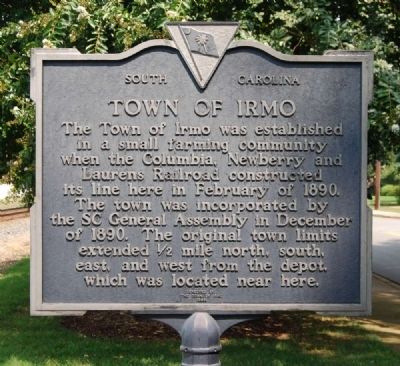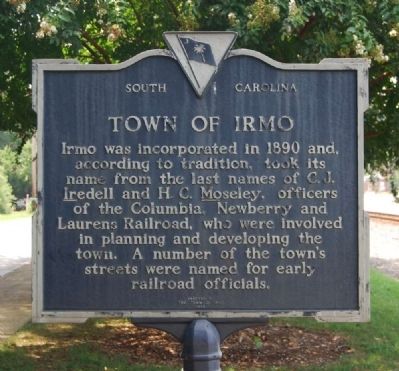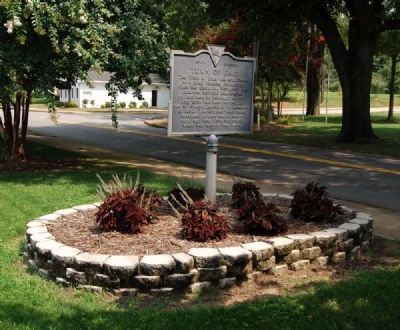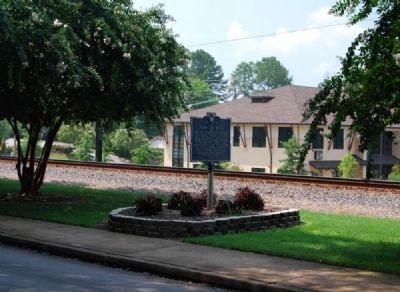Irmo in Lexington County, South Carolina — The American South (South Atlantic)
Town of Irmo
[Front]:
The Town of Irmo was established in a small farming community when the Columbia, Newberry and Laurens Railroad constructed its line here in february of 1890. The town was incorporated by the SC General Assembly in December of 1890. The original town limits extended 1/2 mile north, south, east, and west from the depot, which was located near here.
[Reverse]:
Irmo was incorporated in 1890 and according to tradition, took its name from the last names of C.J. Iredell and H.C. Moseley, officers of the Columbia, Newberry and Laurens Railroad, who were involved in planning and developing the town. A number of the town's streets were named for early railroad officials.
Erected 1989 by Town of Irmo. (Marker Number 32-19.)
Topics. This historical marker is listed in these topic lists: Notable Places • Railroads & Streetcars • Settlements & Settlers. A significant historical month for this entry is February 1890.
Location. 34° 5.038′ N, 81° 10.9′ W. Marker is in Irmo, South Carolina, in Lexington County. Marker is at the intersection of Woodrow Street and Columbia Avenue, on the right when traveling south on Woodrow Street. Touch for map. Marker is in this post office area: Irmo SC 29063, United States of America. Touch for directions.
Other nearby markers. At least 10 other markers are within 7 miles of this marker, measured as the crow flies. Richlex School Site (approx. 1˝ miles away); St. Paul Church / Oak Grove (approx. 1˝ miles away); Bethlehem Church (approx. 1.9 miles away); World War II Bombing Ranges (approx. 2.7 miles away); Lake Murray (approx. 2.7 miles away); Pine Grove Rosenwald School (approx. 3.6 miles away); St. Andrew's Lutheran Church (approx. 3.8 miles away); Zion Lutheran Church / Dreher's Fort (approx. 4.6 miles away); Delingo School (approx. 5.9 miles away); a different marker also named Bethlehem Church (approx. 6.2 miles away). Touch for a list and map of all markers in Irmo.
Also see . . .
1. Town of Irmo, South Carolina. Town website homepage:
Irmo was recognized by Money Magazine in 2007 as the 12th "Most Affordable Place to Live in the Country". (Submitted on August 10, 2009, by Brian Scott of Anderson, South Carolina.)
2. Irmo, South Carolina. Irmo is a town in Lexington and Richland counties in the U.S. state of South Carolina and a suburb of Columbia. (Submitted on August 10, 2009, by Brian Scott of Anderson, South Carolina.)
3. Columbia, Newberry and Laurens Railroad. The Columbia, Newberry and Laurens Railroad (reporting mark CNL) is a historic railroad that operated in South Carolina. (Submitted on August 10, 2009, by Brian Scott of Anderson, South Carolina.)
Additional commentary.
1. About the Columbia, Newberry and Laurens Railroad
The building of the Columbia, Newberry and Laurens Railroad was first agitated, by Mr. H.C. Moseley and Rev. J.A. Sligh, of Prosperity, and Messrs. G.B. Mower and M.A. Carlisle, of Newberry, in the spring and summer of 1835. This railroad was incorporated by Act of the Legislature in 1885, and the Act was amended at the session of 1886. The corporators from Newberry were: J.A. Sligh, H.C. Moselev, G.G. DeWalt, L.S. Bowers, I.M. Wheeler. II, L. Luther. A.G. Wise, G.S. Mower, J.P. Pool, Y.J. Pope. O.B. Mayer, Jr., M.A. Carlisle, Wm. Langford, O.L. Schumpert and Geo. S. Cannon.
A meeting of the corporators was held on 14th January 1880, and appointed a sub-committee to procure 80,000 in private subscriptions.
In the spring of 1880 the first meeting of the stockholders was held at Newberry to see what had been done in the way of securing subscriptions. The $20.000 had to subscribed be before an organization could be effected, and Mr. J.O. Meredith was appointed solicitor to raise this amount in Newberry, Lexington Fork and Columbia.
After that a meeting was held in Columbia and an organization effected as follows: H.C. Moseley, President; R.S. Desportes, Vice-President; C.J. Iredell, Secretary and Treasurer; M.A. Carlisle, Attorney. The other Directors elected were: G.S. Mower, A.G. Wise, J.A. Bligh, M. Chapin, G.B. Shealy, G. Leaphart, W.B. Lowrance, T.T. Moore. After that, township subscriptions were secured as follows:
In Newberry, No. 9 gave first $!5,000; No. 1, $10,000. In Lexington, Raluda, $10.500; Broad River, $15,000; Fork, $14.500; and Columbia, $40,000. Rev. J.A. Sligh and H.C. Moseley, M.A. Carlisle and Gep. S. Mower were largely instrumental in securing the township subscriptions.
Some persons who opposed the township subscriptions carried the matter into the Courts, and the Supreme Court decided they were unconstitutional. This gave the enterprise n black eye, but the Legislature passed a validating Act and the bonds were placed.
Through the influence of the promoters of the scheme a Construction Company was organized in May, 1889, and took the contract to build the road to Newberry.
Mr. H. C. Moseley resigned as President in October, 1889. He had served m that capacity from the beginning of the enterprise three years before, and by the signal ability and skill with which he discharged the difficult work of his position, demonstrated the wisdom and discrimination of those who had placed him at the head of the enterprise. The grading was nearly completed to Newberry; the rock piers for the bridge at Columbia had been built, and the rails were on the ground. He gave up the presidency because of the urgent demands of his private business upon his time. The stockholders at their meeting on October 1st, 1889, adopted unanimously the following resolution offered by Dr. James Woodrow:
"Whereas, our former President, Capt. H.C. Moseley, having declined re-election on account of the increased labors now required of that office and the demands of his private business upon him; and, whereas, the zeal and fidelity displayed by him in his efforts, on behalf of the enterprise now about to be achieved, have been of the highest order, and it is in a great measure due to them that the Columbia, Newberry and Laurens Railroad is now a thing of the near future, be it
"Resolved, That we, the stockholders, extend to him our heartfelt thanks for his services so energetically and unselfishly rendered, and hope that his labors in the future may always be, as they have been in the past,'crowned with an abundant measure of success."
Mr. Moseley was complimented by the directors by being unanimously elected Vice-President, which position he still holds.
Mr. W.G. Childs, a successful financier and business man of Columbia, was elected his successor, and is still President of the road.
Capt. C.J. Iredell, as Secretary and Treasurer, was active and rendered valuable assistance
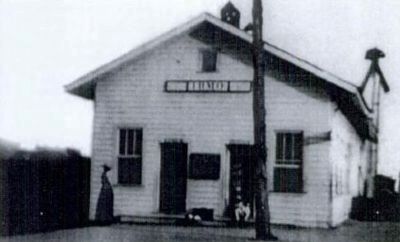
Photographed By South Carolina Postcards Volume IV: Lexington County and Lake Murray, circa 1910
5. Irmo Train Depot
In Irmo and the Dutch Fork Legacy (1990), Furman R.Younginer states that Irmo was the name given to the site about 10 miles from Columbia that was needed for water and refueling the wood-burning locomotives on the new Columbia, Newberry & Laurens Railroad, which began service through the 1-square mile town in July 1890 -- the same year in which the town was incorporated.
The road was completed to Newberry 1st July, 1890, and opened for business 15th July, 1890. It was then built to Clinton, and completed to that point May, 1891. Mr. C.J. Ellis was the Civil Engineer of the road until it was completed. The first year it was operated by the South Carolina Road, but in June 1892, a deal was made with the Atlantic Coast Line, and now it is operated in connection with that road and the Sea Board Air Line. Capt. C.O. Little is the Superintendent, and the road is doing a good business; and it is increasing, thereby demonstrating the wisdom of its friends in projecting the enterprise. It is the reconnecting link between two great systems.
The first train on this road was in charge of Capt. P.C. Gaillard who had, identified himself more fully with Newberry by securing a life partner from among her daughters—Miss Eoline Merchant.
The telegraph line on the Columbia and Greenville Railroad was completed to Newberry on Wednesday, July 5th, 1871. The first dispatch was a congratulatory message sent by President Bush to Thos. M. Paysinger, then Sheriff of the County. Before the war there was, however, a line run several miles towards Columbia from one of the newspaper offices, with the intention of its completion and the publication of a daily newspaper, which was never accomplished. (Source: The Annals of Newberry by John Belton O'Neal, pgs 809-810.)
— Submitted August 10, 2009, by Brian Scott of Anderson, South Carolina.
Credits. This page was last revised on May 19, 2022. It was originally submitted on August 10, 2009, by Brian Scott of Anderson, South Carolina. This page has been viewed 1,603 times since then and 97 times this year. Photos: 1, 2, 3, 4. submitted on August 10, 2009, by Brian Scott of Anderson, South Carolina. 5. submitted on August 14, 2009, by Brian Scott of Anderson, South Carolina.
